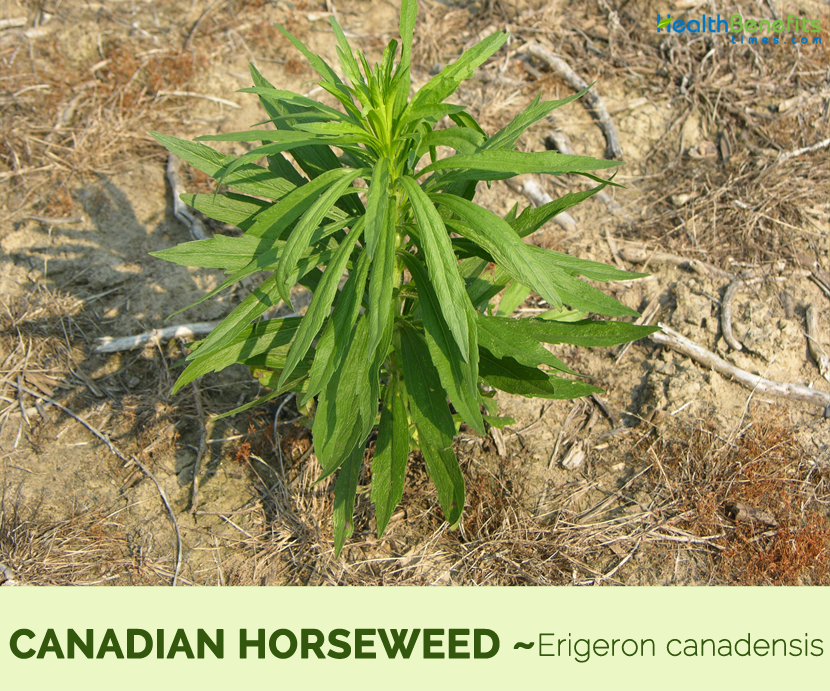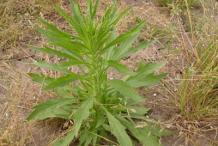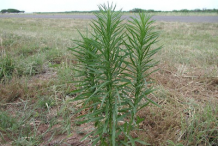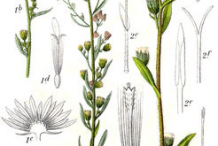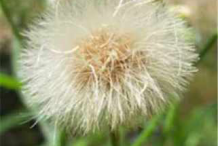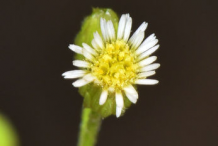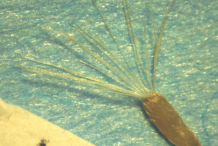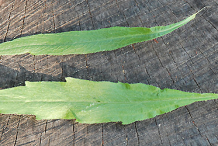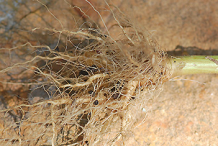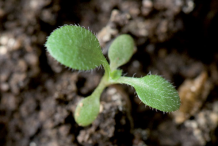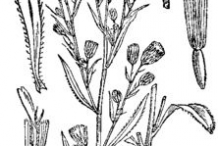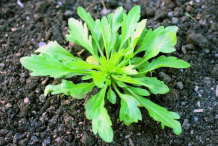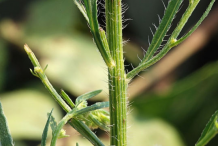Plant Description
Canadian Horseweed is an annual herbaceous weed that grows about 0.5-7 ft. (30-150 cm) tall. The plant prefers dry disturbed areas of gravel prairies, clay prairies, hill prairies, clay banks along rivers, and meadows near woodlands. It is often appears in abandoned fields, pastures, fence rows, vacant lots, garbage dumps, areas along railroads and roadsides, or in gardens and lawns. The plant prefers well-drained light or medium neutral to alkaline, sandy or loamy soil for better growth. The plant has short taproot with fibrous roots and sparsely hairy stems.
Leaves
The alternate leaves are elliptic, narrowly lanceolate, or narrowly oblanceolate, 0.8-3.1 in (2-8 cm) long and 0.08-0.31 in (2-8 mm) wide, with ciliate-serrate leaf margins. The leaves are sessile or almost sessile and are spaced closely together along the stem, appearing almost whorled. Lower leaves are short stalked and often have bristly hairs. Leaves are smaller higher up on the stem. The middle and upper leaves measure up to 8cm long and are 1cm wide and they are stalk less with smooth margins.
Flower & Fruit
This plant has numerous flower heads that measure 0.08-0.16 in (2-4 mm) tall and 0.12-0.28 in (3-7 mm) wide and are crowded into branched terminal clusters. Flower heads are composed of white ray and yellow disc florets. The ray florets are white or purplish and very small, only reaching 0.02-0.04 in (0.5-1.0 mm) in length. Each head contains about 20 disc florets. The flowers typically bloom in June and can last until September. Fertile florets produce a dry pale tan to light gray-brown cypsela with a fluffy pappus and 2 to 3 mm long white bristles attached for wind dispersion. It is a prolific seed producer with approximately 700,000 seeds per pound.
Traditional Uses and benefits of Canadian Horseweed
- Zuni people insert the crushed flowers of the canadensis variety into the nostrils to cause sneezing, relieving rhinitis.
- It is appreciated by Native Americans for assisting in the clotting of the blood and it has also been used to treat rheumatic complaints and gout.
- In traditional North American herbal medicine, Canada fleabane was boiled to make steam for sweat lodges, taken as a snuff to stimulate sneezing during the course of a cold and burned to create a smoke that warded off insects.
- It is valued most for its astringency, being used in the treatment of gastro-intestinal problems such as diarrhea and dysentery.
- It is said to be a very effective treatment for bleeding hemorrhoids.
- Whole plant is antirheumatic, astringent, balsamic, diuretic, emenagogue, styptic, tonic and vermifuge.
- An infusion of the plant has been used to treat diarrhea and internal hemorrhages or applied externally to treat gonorrhea and bleeding piles.
- The leaves are experimentally hypoglycemic.
- Essential oil found in the leaves is used in the treatment of diarrhea, dysentery and internal hemorrhages.
- It is a uterine stimulant and is also said to be valuable in the treatment of inflamed tonsils plus ulceration and inflammation of the throat.
- Tea of the boiled roots is used to treat menstrual irregularities.
- Homeopathic remedy is made from the plant.
- It is used in the treatment of hemorrhoids and painful menstruation.
- It was used by most Native North Americans tribes to treat various illnesses, including diarrhea, fever, running nose, rhinitis, but also used to arrest bleedings or to relieve stomach aches, earaches or headaches.
- Externally, it was made into poultices to treat burns and sore joints.
- Dried and burned as incense it was used to ward off insects.
- It is also used to treat cholera, rheumatism, tuberculosis, bronchitis, inflamed tonsils, diabetes, menopausal symptoms, kidney and bladder conditions, eczema and ringworm.
- It is excellent for colon trouble, cholera and summer complaint.
- It is applied externally to treat bleeding piles and gonorrhea.
- Native people once pulverized the young tops and leaves and ate them raw (similar to using an onion).
- Horseweed is also used in the form of a diuretic to cure bladder complaints, urino-genital ailments, the sexually transmitted disease (STD) gonorrhea and also to get rid of toxic substances when the patient is suffering from rheumatism.
- Horseweed is particularly helpful in every type of passive bleedings, especially when there is an absence of fever and distinct irritation.
- Indigenous tribe of North America, the Lakotas, prepared an herbal tea using the entire horseweed plant to treat children suffering from sore mouths as well as adults who faced problems in passing urine.
- Flowers of horseweed are also blended with a buffalo’s gall, brains and spleen and subsequently massaged on the skin to blanch it in the tanning procedure.
- Navajo tribe in America employed the herb in preparing lotions to treat body pains and headaches.
- Horseweed was also used as a medication to flush out intestinal parasites.
- In Japan and China, the essential oils from C. canadensis are used in the treatment of jaundice, and the oils have been observed to have antifungal effects.
Culinary Uses
- It is a source of an essential oil that is used commercially for flavoring sweets, condiments and soft drink.
- Young leaves, cooked, can be prepared as potherb or used in the same way as other dark greens.
- It can also be dried and used as food spice – it gives an aromatic flavor to dishes.
- Leaves of Canada fleabane can be used as condiment.
- Essential oils obtained from leaves are used to improve flavor of various candies and soft drinks.
Other Facts
- The plant is burned to create a smoke that wards off insects.
- Canada fleabane can be used for making friction fire (via hand drill method).
Precautions
- Skin contact with the plant can cause dermatitis in some people.
- Avoid use during Pregnancy and breast feeding.
References:
https://www.itis.gov/servlet/SingleRpt/SingleRpt?search_topic=TSN&search_value=37113#null
https://davesgarden.com/guides/pf/go/54589/
https://npgsweb.ars-grin.gov/gringlobal/taxonomydetail.aspx?id=104213
https://pfaf.org/user/Plant.aspx?LatinName=Erigeron+canadensis
https://plants.usda.gov/core/profile?symbol=coca5
http://www.theplantlist.org/tpl1.1/record/gcc-115400
http://www.hear.org/pier/species/conyza_canadensis.htm
https://www.invasiveplantatlas.org/subject.html?sub=78282
https://en.wikipedia.org/wiki/Erigeron_canadensis
https://plants.usda.gov/plantguide/pdf/pg_coca5.pdf
https://www.cabi.org/isc/datasheet/15251
https://extension.tennessee.edu/publications/Documents/W106.pdf
Comments
| Canadian Horseweed Quick Facts | |
|---|---|
| Name: | Canadian Horseweed |
| Scientific Name: | Erigeron canadensis |
| Origin | North America and Central America |
| Colors | Pale tan to light gray-brown |
| Shapes | Dry cypsela with a fluffy pappus and 2 to 3 mm long white bristles |
| Taste | Bitter, sub-astringent and amarous taste |
| Health benefits | Beneficial for cholera, rheumatism, tuberculosis, bronchitis, inflamed tonsils, diabetes, menopausal symptoms, kidney and bladder conditions, eczema and ringworm |
| Name | Canadian Horseweed |
|---|---|
| Scientific Name | Erigeron canadensis |
| Native | North America and Central America |
| Common Names | Horseweed, Canadian horseweed, Canadian fleabane, coltstail, marestail, butterweed, Coltstail, Flea Wort, Prideweed, Daisy Fleabane, Philadelphia Fleabane, Sweet Scabious, Frostweed, Fieldweed, Mourning Widow |
| Name in Other Languages | Canada: Mare’s tail Chinese: Xiao peng cao (小蓬草), Jiānádà péng (加拿大蓬), Xiǎo fēipéng (小飞蓬), Fēipéng(飞蓬) Colombia: Cvenadillo Cuba: Conyza, zancarana English: Canadian fleabane, Canadian horseweed, Butterweed, Hogweed, Horseweed, Canada horseweed, Canada fleabane, Canadian horseweed, horseweed fleabane, mare’s tail, mares tail, marestail, blood-stanch, mule tail, pride weed, small-leaf horseweed, colt’s tail, Fijian: Mandramandra Finnish: Kanadankoiransilmä French: Vergerette du Canada, Érigéron du Canada, Conyze du Canada, Tête d’or, herbe gandi, mare’s tail Colombia: Cvenadillo Cuba: Conyza; zancarana German: Kanadisches Berufkraut, Kanadisher katzenschweif Hawaiian: Lani wela India: Jarayupriya Iraq: Thail el-faras Italian: Saeppola canadese, impi Japanese: Himemukashiyomogi Madagascar: Sarijamala Mauritius: Herbe gandi Mexico: Pegajosa Netherlands: Fijnstraal, Canadeese Norway: Canadese fijnstraal, hestehamp Poland: Przymiotno kasnadyjskie Portuguese: Avoadinha Puerto Rico: Pascueta, rozuz Romanian: Bătrîniş South Africa: Armoedskruid, kanadese skraalhans Spanish: Erigeron del Canada, escoba dura, hierba de caballo, altabaca, canem bord, zamarraga hierba impia, olivarda, jarilla, venadillo, cola de zorra Swedish: Kanadabinka Turkey: Sifa out USA: Butterweed; Canada horseweed; fireweed; hogweed Yugoslavia (Serbia and Montenegro): Repusnjaca |
| Plant Growth Habit | Annual herbaceous weed |
| Growing Climate | Dry disturbed areas of gravel prairies, clay prairies, hill prairies, clay banks along rivers, and meadows near woodlands. |
| Soil | Prefers a well-drained light or medium neutral to alkaline, sandy or loamy soil |
| Plant Size | 0.5-7 ft. (30-150 cm) tall |
| Root | Short taproot with fibrous roots |
| Stem | Sparsely hairy stems |
| Leaf | Unstalked, slender, 2–10 centimeters (0.79–3.94 in) long, and up to 1 cm (0.4 inches) across, with a coarsely toothed margin |
| Flowering Periods | Jun to October |
| Flower | Each individual flower has a ring of white or pale purple ray florets and a center of yellow disc florets. |
| Fruit Shape & Size | Fruit is a cypsela tipped with dirty white down |
| Flavor/Aroma | Feeble but pleasant odor |
| Taste | Bitter, sub-astringent and amarous taste |
| Plant Parts Used | Aerial Parts |
| Season | Jul to October |
| Lifespan | One year |


